Tampa, Florida Blood Testing Facilities
 Represents a LabCorp blood testing facility
Represents a LabCorp blood testing facility Represents a Quest Diagnostics blood testing facility
Represents a Quest Diagnostics blood testing facility
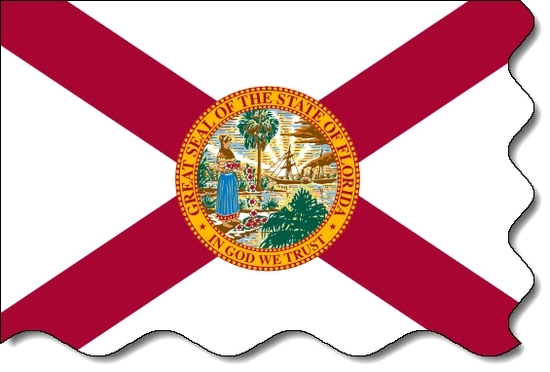
Nearby Labcorp Blood Testing facilities:
- Labcorp Center Distance: 2 m, 2727 W Dr Mlk Blvd Ste 200, Tampa, Hillsborough County, FL, 33607
- Labcorp Center Distance: 5 m, 5610 W La Salle St, Tampa, Hillsborough County, FL, 33607
- Labcorp Center Distance: 9 m, 14438 University Cove Pl, Tampa, Hillsborough County, FL, 33613
- Labcorp Center Distance: 10 m, 11916 Sheldon Rd Ste C, Tampa, Hillsborough County, FL, 33626
- Labcorp Center Distance: 11 m, 11928 Boyette Road, Riverview, Hillsborough County, FL, 33569
- Labcorp Center Distance: 12 m, 1550 Bloomingdale Ave, Valrico, Hillsborough County, FL, 33596
- Labcorp Center Distance: 17 m, 501 Dr Mlk Jr St So Ste B, Saint Petersburg, Pinellas County, FL, 33705
- Labcorp Center Distance: 18 m, 29245 Us Hwy 19 North, Clearwater, Pinellas County, FL, 33761
- Labcorp Center Distance: 19 m, 3901 66Th Street North 102, Saint Petersburg, Pinellas County, FL, 33709
- Labcorp Center Distance: 20 m, 5653 Park St N Ste 2, Saint Petersburg, Pinellas County, FL, 33709
- Labcorp Center Distance: 22 m, 2981B W Bay Dr, Belleair Bluffs, Pinellas County, FL, 33770
- Labcorp Center Distance: 25 m, 5124 Us Highway 19, New Port Richey, Pasco County, FL, 34652
- Labcorp Center Distance: 27 m, 7352 Gall Blvd. Unit 16, Zephyrhills, Pasco County, FL, 33541
- Labcorp Center Distance: 31 m, 13944 Lakeshore Blvd Ste D, Hudson, Pasco County, FL, 34667
- Labcorp Center Distance: 32 m, 3131 Lakeland Hills Blvd Ste 1, Lakeland, Polk County, FL, 33805
- Labcorp Center Distance: 33 m, 2142 E Edgewood Dr, Lakeland, Polk County, FL, 33803
- Labcorp Center Distance: 34 m, 6060 53Rd Ave E Unit C, Bradenton, Manatee County, FL, 34203
- Labcorp Center Distance: 38 m, 8451 Shade Ave Bldg 2 Ste 109, Sarasota, Manatee County, FL, 34243
- Labcorp Center Distance: 40 m, 12114 Cortez Blvd, Brooksville, Hernando County, FL, 34613
- Labcorp Center Distance: 43 m, 1217 East Ave South 103, Sarasota, Sarasota County, FL, 34239
- Labcorp Center Distance: 44 m, 1120 Havendale Blvd Nw, Winter Haven, Polk County, FL, 33881
- Labcorp Center Distance: 45 m, 3920 Bee Ridge Rd Ste A, Sarasota, Sarasota County, FL, 34233
- Labcorp Center Distance: 46 m, 3941 Clark Rd Ste A, Sarasota, Sarasota County, FL, 34233
- Labcorp Center Distance: 52 m, 2209 North Blvd W Ste B, Davenport, Polk County, FL, 33837
- Labcorp Center Distance: 54 m, 1324 State Road 60 E, Lake Wales, Polk County, FL, 33853
- Labcorp Center Distance: 55 m, 7945 S.Suncoast Blvd.Suite A, Homosassa, Citrus County, FL, 34446
- Labcorp Center Distance: 59 m, 333 Tamiami Trl S Ste 173, Venice, Sarasota County, FL, 34285
- Labcorp Center Distance: 61 m, 1920 Don Wickham Dr Ste 205, Clermont, Lake County, FL, 34711
- Labcorp Center Distance: 63 m, 14816 S Tamiami Trl-Ste A-108, North Port, Sarasota County, FL, 34287
- Labcorp Center Distance: 64 m, 4511 Sun N Lake Blvd Ste 105, Sebring, Highlands County, FL, 33872
- Labcorp Center Distance: 65 m, 582 Se 7Th Ave Suite B, Crystal River, Citrus County, FL, 34429
- Labcorp Center Distance: 66 m, 18 Regina Blvd., Beverly Hills, Citrus County, FL, 34465
- Labcorp Center Distance: 67 m, 693 Old Englewood Rd Ste C, Englewood, Sarasota County, FL, 34223
- Labcorp Center Distance: 68 m, 7300 Sandlake Commons Blvd 205, Orlando, Orange County, FL, 32819
- Labcorp Center Distance: 69 m, 1192 Cypress Glen Circle, Kissimmee, Osceola County, FL, 34741
- Labcorp Center Distance: 70 m, 1151 Blackwood Ave Ste 160, Ocoee, Orange County, FL, 34761
- Labcorp Center Distance: 72 m, 317-319 Commerce Ctr Dr, Saint Cloud, Osceola County, FL, 34769
- Labcorp Center Distance: 73 m, 8600A County Road 466. Ste A, The Villages, Sumter County, FL, 32162
- Labcorp Center Distance: 74 m, 25097 E Olympia Ave Ste 206, Punta Gorda, Charlotte County, FL, 33950
- Labcorp Center Distance: 75 m, 4401 S Orange Ave Ste 110, Orlando, Orange County, FL, 32806
- Labcorp Center Distance: 76 m, 1118 So.Orange Ave Ste. 202, Orlando, Orange County, FL, 32806
- Labcorp Center Distance: 77 m, 1706 E Semoran Blvd Ste 114, Apopka, Orange County, FL, 32703
- Labcorp Center Distance: 79 m, 5425 S Semoran Blvd, Orlando, Orange County, FL, 32822
- Labcorp Center Distance: 81 m, 393 Center Pointe Cir Ste 1457, Altamonte Springs, Seminole County, FL, 32701
- Labcorp Center Distance: 82 m, 255 N. Lakemont Ave. Ste 201, Winter Park, Orange County, FL, 32792
- Labcorp Center Distance: 83 m, 1239 Sr 436 Walmart, Casselberry, Seminole County, FL, 32707
- Labcorp Center Distance: 84 m, 705 W State Road 434 Ste J K, Longwood, Seminole County, FL, 32750
- Labcorp Center Distance: 86 m, 2100 Se 17Th St Ste 902, Ocala, Marion County, FL, 34471
- Labcorp Center Distance: 87 m, 2200 N Alafaya Trl Ste 900, Orlando, Orange County, FL, 32826
- Labcorp Center Distance: 88 m, 2500 W Lake Mary Blvd Ste 112, Lake Mary, Seminole County, FL, 32746
- Labcorp Center Distance: 89 m, 1000 W Broadway St Ste 204, Oviedo, Seminole County, FL, 32765
Nearby Quest Blood Testing facilities:
- Quest Center Distance: 3 m, 3440 W Dr Martin Luther King Jr Blvd, Tampa, Hillsborough County, FL, 33607-6223
- Quest Center Distance: 10 m, 11611 Sheldon Rd, Tampa, Hillsborough County, FL, 33626-4306
- Quest Center Distance: 14 m, 3801 Tampa Rd, Oldsmar, Pinellas County, FL, 34677-3008
- Quest Center Distance: 16 m, 3814 State Road 674, Ruskin, Hillsborough County, FL, 33573-6805
- Quest Center Distance: 17 m, 26827 Foggy Creek Rd, Wesley Chapel, Pasco County, FL, 33544-6768
- Quest Center Distance: 20 m, 1219 Cleveland St, Clearwater, Pinellas County, FL, 33755-4908
- Quest Center Distance: 21 m, 6800 Gulfport Blvd S, South Pasadena, Pinellas County, FL, 33707-2193
- Quest Center Distance: 25 m, 4741 Us Highway 19, New Port Richey, Pasco County, FL, 34652-4945
- Quest Center Distance: 26 m, 6719 Gall Blvd., Zephyrhills, Pasco County, FL, 33542-2569
- Quest Center Distance: 30 m, 7459 State Road 52, Hudson, Pasco County, FL, 34667-6714
- Quest Center Distance: 32 m, 3037 Lakeland Hills Blvd Ste 1, Lakeland, Polk County, FL, 33805-2202
- Quest Center Distance: 33 m, 40 Seven Hills Dr, Spring Hill, Hernando County, FL, 34609-0212
- Quest Center Distance: 36 m, 1485 Commercial Way, Spring Hill, Hernando County, FL, 34606-4525
- Quest Center Distance: 37 m, 3041 Landover Blvd., Spring Hill, Hernando County, FL, 34608-7260
- Quest Center Distance: 38 m, 8451 Shade Avenue, Sarasota, Manatee County, FL, 34243-2894
- Quest Center Distance: 40 m, 7007 Nightwalker Rd, Brooksville, Hernando County, FL, 34613-6349
- Quest Center Distance: 48 m, 465 Carlton St, Wauchula, Hardee County, FL, 33873-3400
- Quest Center Distance: 51 m, 161 Webb Drive, Davenport, Polk County, FL, 33837-8990
- Quest Center Distance: 54 m, 1424 State Road 60 E, Lake Wales, Polk County, FL, 33853-4323
- Quest Center Distance: 58 m, 1370 E Venice Ave, Venice, Sarasota County, FL, 34285-9083
- Quest Center Distance: 59 m, 1389 Us Hwy 301, Sumterville, Sumter County, FL, 33585-5141
- Quest Center Distance: 60 m, 265 Citrus Tower Blvd, Clermont, Lake County, FL, 34711-9656
- Quest Center Distance: 61 m, 210 S. Apopka Ave, Inverness, Citrus County, FL, 34452-4606
- Quest Center Distance: 63 m, 1709 E Oak St., Arcadia, Desoto County, FL, 34266-8925
- Quest Center Distance: 64 m, 4315 Sun N Lake Blvd, Sebring, Highlands County, FL, 33872-2162
- Quest Center Distance: 65 m, 3313 S Orange Blossom Trl, Kissimmee, Osceola County, FL, 34746-8815
- Quest Center Distance: 67 m, 2903 Traverse Trl, The Villages, Sumter County, FL, 32163-2017
- Quest Center Distance: 68 m, 413 W Oak St, Kissimmee, Osceola County, FL, 34741-4931
- Quest Center Distance: 69 m, 14050 Town Loop Blvd, Orlando, Orange County, FL, 32837-6190
- Quest Center Distance: 70 m, 10131 W Colonial Dr, Ocoee, Orange County, FL, 34761-4212
- Quest Center Distance: 71 m, 2314 E Irlo Bronson Hwy, Kissimmee, Osceola County, FL, 34744-4420
- Quest Center Distance: 72 m, 11962 County Rd-101, Lady Lake, Sumter County, FL, 32162-9337
- Quest Center Distance: 75 m, 1580 Santa Barbara Blvd, Lady Lake, Sumter County, FL, 32159-6827
- Quest Center Distance: 76 m, 11371 N Williams St, Dunnellon, Marion County, FL, 34432-8340
- Quest Center Distance: 78 m, 8602 Sw State Road 200, Ocala, Marion County, FL, 34481-0484
- Quest Center Distance: 79 m, 324 E Par St, Orlando, Orange County, FL, 32804-4004
- Quest Center Distance: 80 m, 129 Tower St, Lake Placid, Highlands County, FL, 33852-6836
- Quest Center Distance: 82 m, 7780 Lake Underhill Road, Orlando, Orange County, FL, 32822-8780
- Quest Center Distance: 84 m, 1060 West Sr 434, Longwood, Seminole County, FL, 32750-4953
- Quest Center Distance: 85 m, 2685 Sw 32Nd Place, Ocala, Marion County, FL, 34471-7862
- Quest Center Distance: 86 m, 2504 S Alafaya Trl, Orlando, Orange County, FL, 32828-7978
- Quest Center Distance: 87 m, 2000 N Alafaya Trail, Orlando, Orange County, FL, 32826-4719
- Quest Center Distance: 89 m, 1950 W Sr 426, Oviedo, Seminole County, FL, 32765-9145
- Quest Center Distance: 96 m, 2756 Enterprise Road, Orange City, Volusia County, FL, 32763-0000
Florida Hormone Replacement Therapy Services
The Conscious Evolution Institute is one of the premier Hormone Restoration Clinics in the United States and proudly serves the entire state of Florida, as well as every county in the United States. If you are a man or woman over the age of thirty and are interested in the benefits that Hormone Replacement Therapy can provide, we can answer all of your questions, and provide the blood testing and medical diagnosis necessary to help you learn whether HRT Therapy is right for you!
Florida HGH Injection Therapy
Human Growth Hormone Deficiency is a significant medical condition that afflicts many in the United States. As we age, our bodies produce Natural HGH less efficiently over time, and our bodies start to suffer as a result. Growth Hormone is a vitally important metabolic hormone, and when we don't have enough, the body starts to deteriorate more quickly over time.
If you qualify for Bio-Identical HGH Therapy, we can have HGH Injections shipped straight to your home or office.
Florida Sermorelin Injection Therapy
HGH Injections are not the only effective treatment for HGH Deficiency. Sermorelin Acetate is functionally identical to a hormone produced by the human body known as Growth Hormone-Releasing Hormone, and can safely and effectively restore flagging HGH Production.
Both forms of treatment are highly effective, but Sermorelin Acetate is a bit cheaper, and is available for off-label prescription. Your doctor can help you decide which treatment is best for you!
Florida Low-T Treatments
For men, Testosterone is the primary hormone which supports and stimulates manliness. Most men simply think that Testosterone Replacement Therapy is a treatment for Erectile Dysfunction, but Testosterone is vitally important to a wide variety of physiological processes which support and preserve the healthy function of the male body.
Not only does Testosterone stimulate libido and sexual function, it also encourages enhanced muscle strength and endurance, and many men that suffer from Age-Related Low-T also at increased risk of a number of medical conditions including obesity, diabetes, anxiety and insomnia. Testosterone has also been proven to be a highly effective medical treatment for Menopause and osteoporosis.
Florida HCG Weight Loss Therapy
Not all Hormone Therapy Treatments are used expressly to restore hormone balance, some are actually used as medical treatments. For example, a hormone known as HCG has been clinically shown to be a highly effective weight loss aid, especially when combined with a diet method known as Caloric Restriction.
HCG causes the body to burn calories from fat more effectively, and it also reduces the impact of hunger on the human brain, biologically increasing willpower. HCG Injections are nearly painless and are administered just underneath the skin. HCG Injections make it easier to lose weight, and can result in the loss of more than a pound per day.
Largest Cities in Florida
Jacksonville
Jacksonville is the most populous city in the state of Florida. The city also has the unique status of being the largest city by area in the United States. Jacksonville is located in Northeast Florida. Jacksonville is the home of one professional sports team: The Jacksonville Jaguars. Jacksonville is also home of the annual Gator Bowl, an SEC Football game played between Georgia and Florida.
Jacksonville has a very strong and diverse economy, with major opportunities in a number of different fields, including Insurance, Bio-Tech, banking, manufacturing, and distribution. Bi-Lo, Fidelity National Financial, and CSX Transportation are all based in the city.
Miami
Miami is located on the southern tip of Florida, and is widely recognized as one of the most lavish cities in the United States, along the lines of New York City, Los Angeles, and Las Vegas. Although Jacksonville is the largest city in Florida, Miami is the center of one of the largest metro areas in the United States.
Miami has a large Professional Sports scene, due to its population as well as its importance as a high-class tourist destination. Miami is the home of the Miami Dolphins, the Miami Heat, and the Miami Marlins. Miami has a strong and international economy, and there are many lucrative corporations based in the area, including Burger King, Telemundo, and Carnival Cruise Lines. It is also the home of many corporations' Latin American Headquarters.
Tampa
Tampa, Florida is the third largest city in the state of Florida. Tampa Bay is sometimes referred to as Cigar City, because of its historical importance to the American Cigar Industry. Tampa is one of the wealthiest cities in the southeast, and has experienced a huge influx of Americans moving to the area.
Tampa is home to one of the most successful baseball teams of the early 21st century: The Tampa Bay Rays. Tampa Bay is also the home turf of the Tampa Bay Buccaneers. Tampa has a large military presence because of MacDill Air Force Base.
St. Petersburg
St. Petersburg is the fourth largest city in Florida, and is a sister city that belongs in the same metropolitan area as Tampa, separated by Tampa Bay. St. Petersburg goes by the nickname, The Sunshine City, because of the tremendous amount of sunny and beautiful days experienced by the city. Because of this wonderful weather, and the area's great economy, St. Petersburg is both a popular vacation destination as well as a popular retirement location.
St. Petersburg has a strong economy, although many commute to Tampa Bay to work. Among the largest businesses in St. Petersburg are Bayfront Medical Center, the Home Shopping Network, and Raymond James.
Orlando
Orlando is the fifth most populous city in the state of Florida, but is also one of the premier tourist destinations in the United States. Orlando is, by far, most famous for Disney World, one of the largest amusement parks in America and the world.
Orlando is home to one professional sports team, the Orlando Magic. Although the Atlanta Braves are based in Georgia, they play their home Spring Training games at Walt Disney World Resort. Orlando is also home to the University of Central Florida, home of the Knights and the largest public school in Florida.
All About Tampa, Florida Geographic Area
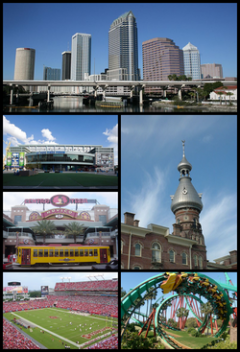
Tampa (pronunciation: /ËntR¦mpÉo/) is a city in the U.S. state of Florida. It serves as the county seat for Hillsborough County and is located on the west coast of Florida, on Tampa Bay near the Gulf of Mexico. The population of Tampa in 2010 was 335,709.
The current location of Tampa was once inhabited by indigenous peoples of the Safety Harbor culture, most notably the Tocobaga and the Pohoy, who lived along the shores of Tampa Bay. It was briefly explored by Spanish explorers in the early 16th century, but there were no permanent American or European settlements within today's city limits until after the United States had acquired Florida from Spain in 1819.
In 1824, the United States Army established a frontier outpost called Fort Brooke at the mouth of the Hillsborough River, near the site of today's Tampa Convention Center. The first civilian residents were pioneers who settled near the fort for protection from the nearby Seminole population. The town grew slowly until the 1880s, when railroad links, the discovery of phosphate, and the arrival of the cigar industry jump-started Tampa's development and helped it to grow into an important city by the early 1900s.
Today, Tampa is a part of the metropolitan area most commonly referred to as the Tampa Bay Area. For U.S. Census purposes, Tampa is part of the Tampa-St. Petersburg-Clearwater, Florida Metropolitan Statistical Area. The four-county area is composed of roughly 2.7 million residents, making it the second largest metropolitan statistical area (MSA) in the state, and the fourth largest in the Southeastern United States, behind Miami, Washington, D.C., and Atlanta. The Greater Tampa Bay area has just over 4 million residents and generally includes the Tampa and Sarasota metro areas. The Tampa Bay Partnership and U.S. Census data showed an average annual growth of 2.47 percent, or a gain of approximately 97,000 residents per year. Between 2000 and 2006, the Greater Tampa Bay Market experienced a combined growth rate of 14.8 percent, growing from 3.4 million to 3.9 million and hitting the 4 million people mark on April 1, 2007.
Tampa has a number of sports teams, such as the Tampa Bay Buccaneers of the National Football League, the Tampa Bay Lightning of the National Hockey League, the Tampa Bay Storm of the Arena Football League, and the Tampa Bay Rowdies of the North American Soccer League. The Tampa Bay Rays in Major League Baseball, are actually based in neighboring St. Petersburg, Florida.
In 2008, Tampa was ranked as the 5th best outdoor city by Forbes. A 2004 survey by the NYU newspaper Washington Square News ranked Tampa as a top city for "twenty-somethings." Tampa is now ranked as a "Gamma" world city by Loughborough University. According to Loughborough, Tampa ranks alongside other world cities such as Phoenix, Santo Domingo, and Osaka. In recent years Tampa has seen a notable upsurge in high-market demand from consumers, signaling more wealth concentrated in the area. Tampa hosted the 2012 Republican National Convention.
The word "Tampa" may mean "sticks of fire" in the language of the Calusa, a Native American tribe that once lived south of today aos Tampa Bay. This might be a reference to the many lightning strikes that the area receives during the summer months. Other historians claim the name means "the place to gather sticks".
Toponymist George R. Stewart writes that the name was the result of a miscommunication between the Spanish and the Indians, the Indian word being "itimpi", meaning simply "near it". The name first appears in the "Memoir" of Hernando de Escalante Fontaneda (1575), who had spent 17 years as a Calusa captive. He calls it "Tanpa" and describes it as an important Calusa town. While "Tanpa" may be the basis for the modern name "Tampa", archaeologist Jerald Milanich places the Calusa village of Tanpa at the mouth of Charlotte Harbor, the original "Bay of Tanpa". A later Spanish expedition did not notice Charlotte Harbor while sailing north along the west coast of Florida and assumed that the current Tampa Bay was the bay they sought. The name was accidentally transferred north.
Map makers were using the term Bay or Bahia Tampa as early as 1695.
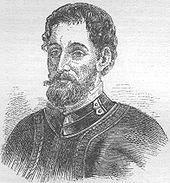
Not much is known about the cultures who called the Tampa Bay area home before European contact. When Spanish explorers arrived in the 1520s, they found a ring of Tocobaga villages around the northern half of Tampa Bay from modern-day Pinellas County to Tampa and Calusa villages along the southern portion of the bay in modern-day Manatee County.
Expeditions led by PR¡nfilo de NarvR¡ez and Hernando de Soto landed near Tampa to look for gold and possibly start a colony. Neither conquistador stayed in the region for long once it became clear that the local riches were only abundant fish and shellfish. The native inhabitants, who derived most of their resources from the sea, repulsed any Spanish attempt to establish a permanent settlement or convert them to Catholicism.
The newcomers brought a weapon against which the natives had no defense: infectious disease. Archeological evidence reveals a total collapse of the native cultures of Florida in the years after European contact. The Tampa area was depopulated and ignored for more than 200 years.
In the mid-18th century, hi events in American colonies drove the Seminole Indians into the wilds of northern Florida. During this period, the Tampa area had only a handful of residents: Cuban and Native American fishermen. They lived in a small village at the mouth of Spanishtown Creek on Tampa Bay, in today aos Hyde Park neighborhood along Bayshore Boulevard.
In 1821, the United States purchased Florida from Spain (see Adams-OnRs Treaty), partly to reduce Indian raids, and partly to eliminate a refuge for escaped slaves from neighboring Southern states. One of the first U.S. actions in its new territory was a raid which destroyed Angola, a settlement built by escaped slaves and free blacks on the eastern shore of Tampa Bay.
The Treaty of Moultrie Creek (1823) created a large Indian reservation in the interior of the peninsula of Florida. As part of efforts to establish control over the vast wilderness, the U.S. government built a series of forts and trading posts in the new territory. "Cantonment Brooke" was established on January 10, 1824, by Colonels George Mercer Brooke and James Gadsden at the mouth of the Hillsborough River on Tampa Bay, at the site of the Tampa Convention Center in Downtown Tampa. On January 22, 1824, the post was officially named Fort Brooke.
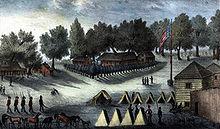
During its first decades of existence, Tampa was very much an isolated frontier outpost. The sparse civilian population practically abandoned the area when the Second Seminole War flared up in late 1835. After almost seven years of vicious fighting, the Seminoles were forced away from the Tampa region and many settlers returned.
The Territory of Florida had grown enough by 1845 to become the 27th state.
Four years after statehood, on January 18, 1849, Tampa had also grown enough to officially incorporate as the "Village of Tampa". Tampa was home to 185 inhabitants, not including military personnel stationed at Fort Brooke. The city's first census count in 1850, however, listed Tampa-Fort Brooke as having 974 residents, inclusive of the military personnel.
Tampa was reincorporated as a town on December 15, 1855, and Judge Joseph B. Lancaster became the first mayor in 1856.
During the American Civil War, Florida seceded along with most of the southern states to form the Confederate States of America. Fort Brooke was manned by Confederate troops, and martial law was declared in Tampa in January 1862. Tampa's city government ceased to operate for the duration of the war.
In late 1861, the Union Navy set up a blockade around many southern ports to cut off the Confederacy from outside help, and several ships were stationed near the mouth of Tampa Bay. Blockade runners based in Tampa were able to repeatedly slip through the blockade to trade cattle and citrus for needed supplies, mainly with Spanish Cuba.
Union gunboats sailed up Tampa Bay to bombard Fort Brooke and the surrounding city of Tampa. The Battle of Tampa on June 30 and July 1, 1862, was inconclusive, as the shells fell ineffectually, and there were no human casualties on either side.
More damaging to the Confederate cause was the Battle of Fort Brooke on October 17 and October 18, 1863. Two Union gunboats shelled the fort and surrounding town and landed troops, who found blockade runners hidden up the Hillsborough River near present-day Lowry Park Zoo and destroyed them. The local militia mustered to intercept the Union troops, but they were able to return to their ships after a short skirmish and headed back out to sea.
The war ended in April 1865 with a Confederate defeat. In May 1865, federal troops arrived in Tampa to occupy the fort and the town as part of Reconstruction. They remained until August 1869.
The Reconstruction period was hard on Tampa. With little industry, and land transportation links limited to bumpy wagon roads from the east coast of Florida, Tampa was a fishing village with very few people, and poor prospects for development. Throughout its history, Tampa had been affected by yellow fever epidemics borne by mosquitoes from the surrounding swampland, but the sickness was particularly widespread during the late 1860s and 1870s. The disease was little understood at the time, and many residents simply packed up and left rather than face the mysterious and deadly peril.
In 1869, residents voted to abolish the city of Tampa government. The population of "Tampa Town" was below 800 in the official 1870 census count and had fallen further by 1880 (see demographics, below).
Fort Brooke, the seed from which Tampa had germinated, had served its purpose and was decommissioned in 1883. Except for two cannons displayed on the nearby University of Tampa campus, all traces of the fort are gone. A large downtown parking garage near the old fort site is called the Fort Brooke Parking Garage.
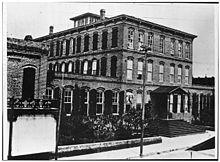
In the mid-1880s, Tampa's fortunes took several sudden turns for the better. First, phosphate was discovered in the Bone Valley region southeast of Tampa in 1883. The mineral, vital for the production of fertilizers and other products, was soon being shipped out from the Port of Tampa in great volume. Tampa is still a major phosphate exporter.
Henry B. Plant's railroad line reached Tampa and its port shortly thereafter, finally connecting the small town to the nation's railroad system after years of efforts by local leaders. Previously, Tampa's overland transportation links had consisted of rutted sandy roads stretching across the Florida countryside. Plant's railroad made it much easier to get goods in and out of the Tampa Bay area. Phosphate and commercial fishing exports could be sent north and many new products were brought into the Tampa market, along with the first tourists.
The new railroad link enabled another important industry to come to Tampa. In 1885, the Tampa Board of Trade enticed Vicente Martinez Ybor to move his cigar manufacturing operations to Tampa from Key West. Proximity to Cuba made importation of "clear Havana tobacco" easy by sea, and Plant's railroad made shipment of finished cigars to the rest of the US market easy by land.
Since Tampa was still a small town at the time (population less than 5000), Ybor built hundreds of small houses around his factory to accommodate the immediate influx of mainly Cuban and Spanish cigar workers. Ybor City's factories rolled their first cigars in 1886, and many different cigar manufacturers moved their operations to town in ensuing years. Many Italian and a few eastern European Jewish immigrants arrived starting in the late 1880s, opening businesses and shops that catered to cigar workers. By 1900, over 10,000 immigrants had moved to the neighborhood. Several thousand more Cuban immigrants built West Tampa, another cigar-centric suburb founded a few years later by Hugh MacFarlane. Between them, two "Latin" communities combined to exponentially expand Tampa's population, economic base, and tax revenues, as Tampa became the "Cigar Capital of the World".

In 1891, Henry B. Plant built a lavish 500+ room, quarter-mile (400 m) long, US$2.5 million eclectic/Moorish Revival-style luxury resort hotel called the Tampa Bay Hotel among 150 acres (0.61 km2) of manicured gardens along the banks of the Hillsborough River. Plant's resort featured a race track, a heated indoor pool, a golf course, a 2000-seat auditorium, tennis courts, stables, hunting and fishing tours, and electric lights and telephones in every room, plus the first elevator in town and exotic art collectibles which Plant had shipped in from around the world.
The Tampa Bay Hotel was relatively prosperous for about a decade. The resort hosted thousands of guests and many celebrities of the era, but was only filled to capacity during the Spanish-American War (see below). Henry Plant died in 1899, and his heirs sold the facilities to the city of Tampa in 1904. The city operated the hotel and used the grounds as a community gathering place until 1932, when the resort was closed, remodeled, and reopened as the University of Tampa a year later.
Mainly because of Henry Plant's connections in the War Department, Tampa was chosen as an embarkation center for American troops in the Spanish-American War. Lieutenant Colonel Theodore Roosevelt and his Rough Riders were among the 30,000 troops who waited in Tampa for the order to ship out to Cuba during the summer of 1898, filling the town to bursting and delivering another huge boost to the local economy.
The discovery of phosphate, the arrival of Plant's railroad, and the founding of Ybor City and West Tampa aeall in the mid-1880s aewere crucial to Tampa's development. The once-struggling village of Tampa became a bustling boomtown almost overnight, and had grown into one of the largest cities in Florida by 1900.
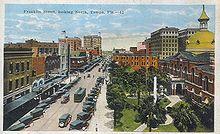
During the first few decades of the 20th century, the cigar-making industry was the backbone of Tampa's economy. The factories in Ybor City and West Tampa made an enormous number of cigars aein the peak year of 1929, over 500,000,000 cigars were hand rolled in the city.
In 1904, a local civic association of local businessmen dubbed themselves Ye Mystic Krewe of Gasparilla (named after local mythical pirate Jose Gaspar), and staged an "invasion" of the city followed by a parade. With a few exceptions, the Gasparilla Pirate Festival has been held every year since.
Beginning in the late 19th century, illegal bolita lotteries were very popular among the Tampa working classes, especially in Ybor City. In the early 1920s, this small-time operation was taken over by Charlie Wall, the rebellious son of a prominent Tampa family, and went big-time. Bolita was able to openly thrive only because of kick-backs and bribes to key local politicians and law enforcement officials, and many were on the take.
Profits from the bolita lotteries and Prohibition-era bootlegging led to the development of several organized crime factions in the city. Charlie Wall was the first major boss, but various power struggles culminated in consolidation of control by Sicilian mafioso Santo Trafficante, Sr., and his faction in the 1950s. After his death in 1954 from cancer, control passed to his son Santo Trafficante, Jr., who established alliances with families in New York and extended his power throughout Florida and into Batista-era Cuba.
The era of rampant and open corruption ended in the 1950s, when the Senator Kefauver's traveling organized crime hearings came to town and were followed by the sensational misconduct trials of several local officials. Although many of the worst offenders in government and the mob were not charged, the trials helped to end the sense of lawlessness which had prevailed in Tampa for decades.
Tampa grew considerably as a result of World War II. Prior to the United States' involvement in the conflict, construction began on MacDill Field, the predecessor of present day MacDill Air Force Base. MacDill Field served as a main base for Army Air Corps and later Army Air Forces operations just before and during World War II, with multiple auxiliary airfields around the Tampa Bay area and surrounding counties. At the end of the war, MacDill remained as an active military installation while the auxiliary fields reverted to civilian control. Two of these auxiliary fields would later become the present day Tampa International Airport and St. Petersburg-Clearwater International Airport. With the establishment of an independent U.S. Air Force in 1947, MacDill Field became MacDill AFB.
During the 1950s and 1960s Tampa saw record-setting population growth that has not been seen since. This amazing growth spurred major expansion of the city aos highways and bridges bringing thousands into the city and creating endless possibilities for Tampa business owners who welcomed tourists and new citizens alike into their neighborhoods. It was during this time period in the city aos history that two of the most popular tourist attractions in the area were developed ae Busch Gardens and Lowry Park. Many of the well-known institutions that play an important role in the economic development of the city were established during this time period.
In 1956, the University of South Florida was established in North Tampa, spurring major development in this section of the city and offering many new job opportunities. Tampa continued to expand as new hospitals, schools, churches and subdivisions all began appearing to accommodate the growth. Many business offices began moving away from the traditional downtown office building into more convenient neighborhood office plazas.
Four attempts have been made to consolidate the municipal government of the city of Tampa with the county government of Hillsborough County (1967, 1970, 1971, and 1972), all of which failed at the ballot box; the greatest loss was also the most recent attempt in 1972, with the final tally being 33,160 (31%) in favor and 73,568 (69%) against the proposed charter.
The biggest recent growth in the city was the development of New Tampa, which started in 1988 when the city annexed a mostly rural area of 24 square miles (62 km2) between I-275 and I-75.
East Tampa, historically a mostly black community, was the scene of several race riots during and for some time after the period of racial segregation, mainly due to problems between residents and the Tampa Police Department.
As of 2000, the largest European ancestries in the city were German (9.2%), Irish (8.4%), English (7.7%), Italian (5.6%), and French (2.4%).
As of 2010, there were 157,130 households out of which 13.5% were vacant. In 2000, 27.6% households had children under the age of 18 living with them, 36.4% were married couples living together, 16.1% had a female householder with no husband present, and 42.9% were non-families. 33.7% of all households were made up of individuals and 10.2% had someone living alone who was 65 years of age or older. The average household size was 2.36 and the average family size was 3.07.
In 2000, the city's population was spread out with 24.6% under the age of 18, 10.0% from 18 to 24, 32.3% from 25 to 44, 20.5% from 45 to 64, and 12.5% who were 65 years of age or older. The median age was 34.7 years old. For every 100 females there were 95.3 males. For every 100 females age 18 and over, there were 92.1 males.
In 2006, the median income for a household in the city was $39,602, and the median income for a family was $45,823. Males had a median income of $40,461 versus $29,868 for females. The per capita income for the city was $26,522. 20.1% of the population and 16.4% of families were below the poverty line. 31.0% of those under the age of 18 and 13.6% of those 65 and older are living below the poverty level.
As of 2000, English spoken as a first language accounted for 77.4% of all residents, while 22.6% spoke other languages as their mother tongue. The most significant was Spanish speakers who made up 17.8% of the population, while French came up as the third most spoken language, which made up 0.6%, and Italian was at fourth, with 0.6% of the population.
A 2006 study by UCLA suggests that Tampa has one of the highest GLBT populations per capita with 6.1% of citizens polled identifying as gay, lesbian, bisexual or transexual. The Tampa Bay metropolitan area also ranks 5th of all major metropolitan areas with 5.9% being GLBT.
Tampa is located on the West coast of Florida at 27 °58 a²15 a³N 82 °27 a²53 a³W / 27.97083 °N 82.46472 °W / 27.97083; -82.46472 (27.970898, na82.464640).
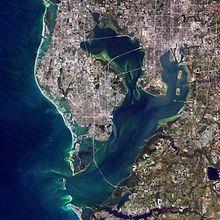
According to the United States Census Bureau, the city has a total area of 170.6 square miles (442 km2) including 112.1 square miles (290 km2) of land and 58.5 square miles (151.5 km2) (34.31%) of water. The highest point in the city is only 48 feet (15 m). Tampa is bordered by two bodies of water, Old Tampa Bay and Hillsborough Bay, both of which flow together to form Tampa Bay, which in turn flows into the Gulf of Mexico. The Hillsborough River flows out into Hillsborough Bay, passing directly in front of Downtown Tampa and supplying Tampa's main source of fresh water. Palm River is a smaller river flowing from just east of the city into McKay Bay, which is a smaller inlet, sited at the northeast end of Hillsborough Bay Tampa's cartography is marked by the Interbay Peninsula which divides Hillsborough Bay (the eastern) from Old Tampa Bay (the western).
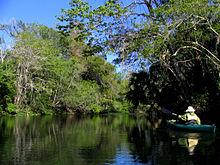
Tampa has a humid subtropical climate (Koppen Cfa), with hot summer days, frequent thunderstorms in the summer (rain is less frequent in the fall and winter), and a threat of a light winter freeze from November 15 through March 5 caused by occasional cold fronts from the north, and even then not every year in southern Tampa and near the bay. Light freezes every year are more likely in northern Tampa and the Tampa Palms area. Since Tampa has some characteristics of a tropical climate, hard freezes (defined by the National Weather Service as below 28 °F ( na2.2 °C)) happen rarely (every 5 to 20 years depending on location). Because of Tampa Bay, Tampa is split between two USDA climate zones. According to the 2012 USDA Plant Hardiness Zone Map, Tampa is listed as USDA zone 9b north of Kennedy Boulevard away from the bay and 10a south of Kennedy Boulevard and along the bay, Zone 10a is about the northern limit of where coconut palms and royal palms can be grown, although some specimens do grow in northern Tampa. Southern Tampa has much more tropical foliage than the northern parts of the city. Average highs range from 70 to 90 °F (21 to 32 °C) year round, and lows 52 to 76 °F (11 to 24 °C). While it may surprise anyone who has suffered the area's intense summer heat, Tampa's official recorded high has never hit 100 °F (37.8 °C) ae the all-time record high temperature is 99 °F (37 °C), recorded on June 5, 1985.
Temperatures are hot from around mid-May through mid-October, which coincides approximately with the rainy season. Summertime weather is very consistent, with highs near 90 °F (32 ae34 °C), lows in the mid-70s °F (23 ae24 °C), and high humidity. Afternoon thunderstorms, usually generated by the interaction of the Gulf and Atlantic sea breezes, are such a regular occurrence during the summer that the Tampa Bay area is recognized as the "Lightning Capital of North America". Every year, Florida averages 10 deaths and 30 injuries from lightning strikes, with several of these usually occurring in or around Tampa.
In the winter, average temperatures range from the low to mid 70s during the day to the low to mid 50s at night. However, sustained colder air from Canada pushes into the area on several occasions every winter, dropping the highs and lows to 15 degrees below the average (or even colder) for several days at a time before seasonal average temperatures return. The temperature can fall below freezing an average of 2 to 3 times per year, though this does not occur every season. Since the Tampa area is home to a diverse range of freeze-sensitive agriculture and aquaculture, hard freezes, although very infrequent, are a major concern. The lowest temperature ever recorded in Tampa was 18 °F ( na8 °C) on December 13, 1962.
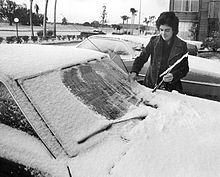
In the Great Blizzard of 1899, Tampa experienced its one and only known blizzard, with "bay effect" snow coming off Tampa Bay. The last measurable snow in Tampa fell on January 19, 1977. The accumulation amounted to all of 0.2 inches (0.5 cm), but the city, unprepared for and unaccustomed to wintry weather, came to a virtual standstill for a day.
The last trace of snow occurred on January 11, 2010 during a prolonged cold snap where there was a hard freeze in the northern parts of Tampa. The temperature fell as low as 23 °F ( na5.0 °C) during this cold snap. On January 11, 2010, sleet (mixed with rain and a few snowflakes) fell in northern Tampa and further north according to a CoCoRaHS observer. According to CoCoRaHS observers and the National Weather Service, this was the longest stretch of cold weather in the history of Tampa. It has been colder, but never this cold this long. Temperatures did not get above 49 °F (9.4 °C) for 5 days and there were freezes every night in northern Tampa for a week straight. There was significant damage to tropical foliage all over Tampa.
Three major freezes occurred in the 1980s: in January 1982, January 1985, and December 1989. The losses suffered by farmers forced many to sell off their citrus groves, which helped fuel a boom in subdivision development in the 1990s and 2000s.
With the frequent afternoon thunderstorms in the summer, there are occasional bouts of severe weather. While hail is not common, it does occur on occasion, especially in the spring and fall. Strong straight line winds are common as are downbursts. Tornadoes are actually quite common with the afternoon storms in Tampa, but they tend to be quite weak and short-lived. They touch down, damage a few screen lanais and then dissipate. They are usually EF0 on the Enhanced Fujita Scale. Tampa does occasionally have stronger tornadoes usually associated with a cold front passage in the winter, These tornadoes can occur night or day and have caused significant damage. An F4 (Old Fujita scale) struck northern Tampa and the University of South Florida on April 4, 1966 causing severe damage and killing 3 people in north Tampa.
Waterspouts are frequent in Tampa Bay in the summer. They tend to be associated with towering cumulus clouds as well as the afternoon thunderstorms. Tornadic waterspouts do occur with the passage of frontal systems. These waterspouts occasionally move onshore and become tornadoes and can do significant damage to shoreline areas.
Tampa has not been hit with a significant hurricane since the 1921 Tampa Bay hurricane. In 2004, Hurricane Charley was forecast to make a direct hit on Tampa. This caused one of the largest evacuations in history with many residents taking refuge in the Orlando area. Instead the storm suddenly intensified to a category 4 hurricane, unexpected hooked to the right, and slammed into Punta Gorda. It then traveled across the state hitting Orlando, where many Tampa residents had taken refuge, as a category 2 storm.
Because of the frequent summer thunderstorms, Tampa has a pronounced wet season, receiving an average of 26.1 inches (663 mm) of rain from June to September but only about 18.6 inches (472 mm) during the remaining eight months of the year. The historical averages during the late summer, especially September, are augmented by passing tropical systems, which can easily dump many inches of rain in one day. Tropical Storm Debby in 2012 dropped 8.57 inches of rain at Tampa International Airport on June 24, 2012 and amounts up to 10.36 inches was reported by a CoCoRaHS observer in NW Tampa. Outside of the summer rainy season, most of the area's precipitation is delivered by the occasional passage of a weather front.

Tampa displays a wide variety of architectural designs and styles. Most of Tampa's high rises demonstrate Post-modern architecture. The design for the renovated Tampa Museum of Art, displays Post-modern architecture, while the city hall and the Tampa Theatre belong to Art Deco architecture. The Tampa mayor Pam Iorio made the redevelopment of Tampa's downtown, especially residential development, a priority. Several residential and mixed-development high-rises have been constructed. Another of Mayor Iorio's initiatives was the Tampa Riverwalk, a mixed use path along the Hillsborough River in downtown and Channelside. Several museums are part of the plan, including new homes for the Tampa Bay History Center, the Tampa Children's Museum, and the Tampa Museum of Art. Mayor Bob Buckhorn has continued these developments.
Tampa is the site of several skyscrapers. Overall, there are 18 completed buildings that rise over 250 feet (76 m) high. The city also has 69 high-rises, more than any other city in Florida after Miami. The tallest building in the city is 100 North Tampa, formerly the AmSouth Building, which rises 42 floors and 579 feet (176 m) in Downtown Tampa. The structure was completed in 1992, and is the tallest building in Florida outside of Miami and Jacksonville.
The city is divided into many neighborhoods, many of which were towns and unincorporated communities annexed by the growing city. Generally, the city is divided into the following areas: Downtown Tampa, New Tampa, West Tampa, East Tampa, North Tampa, and South Tampa. Well-known communities include Ybor City, Forest Hills, Ballast Point, Sulphur Springs, Seminole Heights, Tampa Heights, Palma Ceia, Hyde Park, Davis Islands, Tampa Palms, College Hill, and non-residential areas of Gary and the Westshore Business District.
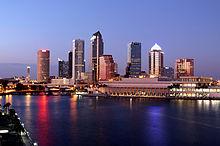
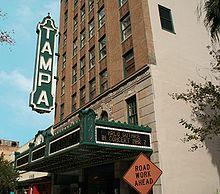
The Sulphur Springs Water Tower, a landmark in Sulphur Springs section of the city, dates back to the late 1920s. This boom period for Florida also saw the construction of an ornate movie palace, the Tampa Theatre, a Mediterranean revival on Davis Islands, and Bayshore Boulevard, which borders Hillsborough Bay from downtown Tampa to areas in South Tampa. The road has a 6-mile (9.7 km) continuous sidewalk on the eastern end, the longest in the world.
The Ybor City District is home to several buildings on the National Register of Historic Places and has been declared a National Historic Landmark. Notable structures include El Centro EspaR±ol and other social clubs built in the early 1900s.
Babe Zaharias Golf Course in the Forest Hills area of Tampa has been designated a Historical Landmark by the National Register of Historic Places. It was bought in 1949 by the famous 'Babe', who had a residence nearby, and closed upon her death. In 1974, the city of Tampa opened the golf course to the public. The Story of Tampa, a public painting by Lynn Ash, is a 4' R— 8' oil on masonite mural that weaves together many of the notable aspects of Tampa's unique character and identity. It was commissioned in 2003 by the city's Public Art Program and can be found in the lobby of the Tampa Municipal Office Building. Park Tower (originally the First Financial Bank of Florida) is the first substantial skyscraper in downtown Tampa. Completed in 1973, it was the tallest skyscraper in Tampa until the completion of One Tampa City Center in 1981. The Rivergate building, a cylindrical building known as the "Beer Can building", was featured in the movie "The Punisher".
Spanning the southern part of Tampa Bay, is the massive steel-span Sunshine Skyway Bridge.
Tampa is home to the Bro Bowl, one of the last remaining skateparks built during skateboarding's "Golden Era" in the 1970s. It opened in 1979 and was constructed by Tampa Parks and Recreation. It was the first public skatepark to be constructed in Florida and the third on the East Coast.
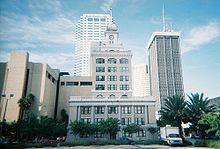
Tampa is governed under the strong mayor form of government. The Mayor of Tampa is the chief executive officer of city government and is elected in four-year terms, with a limit of two consecutive terms. The current mayor is Bob Buckhorn, who took office on April 1, 2011.
The City Council is a legislative body served by seven members, in which four are elected from specific areas of town and the other three are "at-large" (serving citywide).
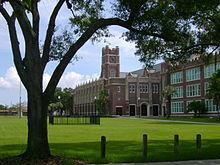
Public primary and secondary education is operated by Hillsborough County Public Schools, officially known as the School District of Hillsborough County (SDHC). It is ranked the eighth largest school district in the United States, with around 189,469 enrolled students. SDHC runs 208 schools, 133 being elementary, 42 middle, 27 high schools, two K-8s, and four career centers. There are 73 additional schools in the district that are charter, ESE, alternative, etc. Twelve out of 25 high schools in the SDHC are included in Newsweek's list of America's Best High Schools.
Tampa's library system is operated by the Tampa-Hillsborough Public Library System. THPLS operates 28 libraries throughout Tampa and Hillsborough County, including the John F. Germany Main Library in Downtown Tampa. The Tampa library system first started in the early 20th century, with the West Tampa Library, which was made possible with funds donated by Andrew Carnegie.
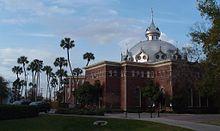
There are a number of institutions of higher education in Tampa. The city is home to the main campus of the University of South Florida (USF), a member of the State University System of Florida founded in 1956. In 2010, it was the eleventh highest individual campus enrollment in the US with over 46,000 students. Its mascot is Rocky The Bull, with green and gold as his colors. The University of Tampa (UT) is a private, four-year liberal arts institution. Founded in 1931 and located across the Hillsborough River from downtown Tampa, UT has over 6,500 students attending. Its mascot is the Spartan, with scarlet, black, and gold as its school colors. Hillsborough Community College is a two-year community college in the Florida College System with campuses in Tampa and Hillsborough County.
Other colleges and universities in the wider Tampa Bay Area include Eckerd College and St. Petersburg College in St. Petersburg.
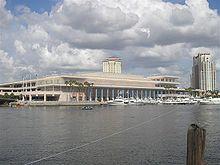
Service, retail, finance, insurance, shipping by air and sea, national defense, professional sports, tourism, and real estate all play a vital role in the area's economy. Hillsborough County alone has an estimated 740,000 employees, a figure which is projected to increase to 922,000 by 2015. Many corporations, such as large banks and telecommunications companies, maintain regional offices in Tampa. Several Fortune 1000 companies are headquartered in the metropolitan area, including OSI Restaurant Partners, WellCare Health Plans, Inc., TECO Energy, and Raymond James Financial. MacDill Air Force Base also remains a major employer as the parent installation for over 15,000 active uniformed military, Department of Defense (DoD) civil service and DoD contractor personnel in the Tampa Bay area. A significant majority of the civil service and contractor personnel are, in fact, themselves retired career military personnel. In addition to the 6th Air Mobility Wing, which is "host wing" for the base, MacDill is also home to Headquarters, United States Central Command (USCENTCOM), Headquarters, United States Special Operations Command (USSOCOM), the 927th Air Refueling Wing, Headquarters, United States Marine Forces Central Command (USMARCENT), Headquarters, United States Special Operations Command Central (USSOCCENT), and numerous other military activities of the active and reserve components of the armed forces.
Downtown Tampa is undergoing significant development and redevelopment in line with a general national trend toward urban residential development. The Tampa Downtown Partnership notes development proceeding on 20 residential, hotel, and mixed-use projects as of April 2007. Many of the new downtown developments are nearing completion in the midst of a housing market slump, which has caused numerous projects to be delayed or revamped, and some of the 20 projects TDP lists have not broken ground and are being refinanced. Nonetheless several developments are nearing completion, which city leaders hope will make downtown into a 24-hour neighborhood instead of 9 to 5 business district. As it stands, Tampa residents face a decline in rent which has decreased an average of 2% next year. Nationally rent has decreased 4%.
Tampa's port is now the seventh largest in the nation and Florida's largest tonnage port, handling nearly half of all seaborne commerce that passes through the state. Tampa currently ranks second in the state behind Miami in terms of cruise ship travel. Besides smaller regional cruise ships such as Yacht Starship and SunCruz Casino, Tampa also serves as a port of call for three cruise lines: Holland America's MS Veendam, Royal Caribbean's Grandeur of the Seas, and Carnival's Legend and Inspiration.
The main server farm for Wikipedia and other Wikimedia Foundation projects is located in Tampa.
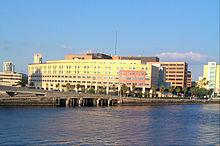
Tampa and its surrounding suburbs are host to over 20 hospitals and four trauma centers. Three of the area's hospitals were ranked among "America's best hospitals" by US News and World Report. It is also home to many health research institutions. The major hospitals in Tampa include Tampa General Hospital, St. Joseph's Children's & Women's Hospital, James A. Haley Veterans Hospital, H. Lee Moffitt Cancer Center & Research Institute and The Pepin Heart Institute. Along with human health care, there are hundreds of animal medical centers including a Humane Society of America.
Major daily newspapers serving the city are The Tampa Tribune and The Tampa Bay Times. La Gaceta is the nation's only trilingual newspaper, written in English, Spanish, and Italian. There is also a wide variety of smaller regional newspapers, alternative weeklies, and magazines, including the Florida Sentinel Bulletin, Creative Loafing, Reax Music Magazine, Tampa Bay Times, The Oracle, Tampa Bay Business Journal, and MacDill Thunderbolt. Major television affiliates include WFTS 28 (ABC), WTSP 10 (CBS), WFLA 8 (NBC), WTVT 13 (Fox), WTOG 44 (The CW), WTTA 38 (MyNetworkTV), and WVEA 62 (Univision).
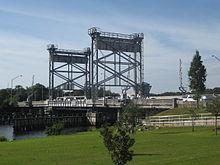
Water in the area is managed by the Southwest Florida Water Management District. The water is mainly supplied by the Hillsborough River, which in turn arises from the Green Swamp, but several other rivers and desalination plants in the area contribute to the supply. Power is mainly generated by TECO Energy.
Phone service is provided by Verizon and Bright House Networks. Cable TV and internet are also provided by these companies.
Three motor vehicle bridges cross Tampa Bay to Pinellas County: the Howard Frankland Bridge (I-275), the Courtney Campbell Causeway (SR-60), and the Gandy Bridge (US 92). The old Gandy Bridge was completely replaced by new spans during the 1990s, but a span of the old bridge was saved and converted into a pedestrian and biking bridge renamed The Friendship Trail. It is the longest overwater recreation trail in the world. However, the bridge was closed in 2008 due to structural problems.
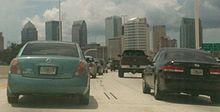
There are two major expressways (toll) bringing traffic in and out of Tampa. The Lee Roy Selmon Expressway (SR-618) (formerly known as the Crosstown Expressway), runs from suburban Brandon at its eastern terminus, through Downtown Tampa, to the neighborhoods in South Tampa (near MacDill Air Force Base) at its western terminus. The Veterans Expressway (SR-589), meanwhile connects Tampa International Airport and the bay bridges to the northwestern suburbs of Carrollwood, Northdale, Westchase, Citrus Park, Cheval, and Lutz, before continuing north as the Suncoast Parkway into Pasco and Hernando counties.
Three interstate highways run through the city. Interstate 4 and Interstate 275 cut across the city and intersect near downtown. Interstate 75 runs along the east side of town for much of its route through Hillsborough County until veering to the west to bisect New Tampa.
Along with highways, major surface roads serves as main arteries of the city. These roads are Hillsborough Avenue (US 92 and US 41), Dale Mabry Highway (US 92), Nebraska Avenue (US 41/SR 45), Florida Avenue (US 41 Business), Bruce B. Downs Boulevard, Fowler Avenue, Busch Boulevard, Kennedy Boulevard, Adamo Drive, and Dr. Martin Luther King Jr. Boulevard.
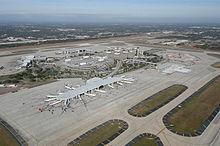
Tampa holds a unique distinction in the history of aviation, a status gained just ten years after the Wright Brothers first took flight in Kitty Hawk, North Carolina. On January 1, 1914, pioneering aviator Tony Jannus captained the inaugural flight of the St. Petersburg-Tampa Airboat Line, the world's first commercial passenger airline. The airline flew scheduled flights from downtown St. Petersburg, Florida, across the bay to just south of where Tampa International Airport sits today, carrying just the pilot and a single passenger in a flying boat biplane. The airline's historic significance is officially recognized by the Smithsonian National Air and Space Museum, and its pilot is memorialized annually by the awarding of the Tony Jannus Award to individuals of outstanding achievement in scheduled commercial aviation. A permanent exhibit honoring the award recipients is maintained at Tampa International Airport, which also hosts a 12.5 feet (3.8 m) painted mural from the 1930s titled, History aos First Scheduled Airline Passenger Arrives in Tampa, depicting the events of New Year's Day, 1914.[100]
 Tampa International Airport (IATA: TPA, ICAO: KTPA) is Tampa's main airport and the primary location for commercial passenger airline service into the Tampa Bay area. It is also a consistent favorite in surveys of the industry and the traveling public. The readers of Conde Nast Traveler have frequently placed Tampa International in their list of Best Airports, ranking it #1 in 2003,[101] and #2 in 2008[102] A survey by Zagat in 2007 ranked Tampa International first among U.S. airports in overall quality.[103] During 2008, it was the 26th-busiest airport in North America.[104]
Tampa International Airport (IATA: TPA, ICAO: KTPA) is Tampa's main airport and the primary location for commercial passenger airline service into the Tampa Bay area. It is also a consistent favorite in surveys of the industry and the traveling public. The readers of Conde Nast Traveler have frequently placed Tampa International in their list of Best Airports, ranking it #1 in 2003,[101] and #2 in 2008[102] A survey by Zagat in 2007 ranked Tampa International first among U.S. airports in overall quality.[103] During 2008, it was the 26th-busiest airport in North America.[104]  Peter O. Knight Airport (IATA: TPF, ICAO: KTPF)is a small general aviation terminal located on Davis Islands near downtown.
Peter O. Knight Airport (IATA: TPF, ICAO: KTPF)is a small general aviation terminal located on Davis Islands near downtown.  Tampa Executive Airport (IATA: VDF, ICAO: KVDF), formerly known as Vandenberg Airport, is another option for general aviation fliers. The airport is located east of Tampa in Hillsborough County, near the interchange of I-4 and I-75.
Tampa Executive Airport (IATA: VDF, ICAO: KVDF), formerly known as Vandenberg Airport, is another option for general aviation fliers. The airport is located east of Tampa in Hillsborough County, near the interchange of I-4 and I-75.  St. Petersburg-Clearwater International Airport (IATA: PIE, ICAO: KPIE) lies just across the bay from Tampa International Airport in neighboring Pinellas County. Though mainly a general aviation facility, the airport has become a popular destination for passenger service by discount and charter carriers. A joint civil-military aviation facility, it is also home to Coast Guard Air Station Clearwater, the largest air station in the U.S. Coast Guard.[105]
St. Petersburg-Clearwater International Airport (IATA: PIE, ICAO: KPIE) lies just across the bay from Tampa International Airport in neighboring Pinellas County. Though mainly a general aviation facility, the airport has become a popular destination for passenger service by discount and charter carriers. A joint civil-military aviation facility, it is also home to Coast Guard Air Station Clearwater, the largest air station in the U.S. Coast Guard.[105] 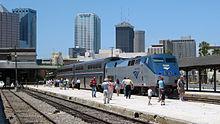
The railroad legacy brought to Tampa by Henry Plant continues to serve the city. Uceta Rail Yard was established by Plant System corporate descendant, Atlantic Coast Line Railroad, in the industrial sector on Tampa's east side, between Gary and Brandon. It continues to service CSX as a storage and intermodal freight transport facility today. Freight and container cargo operations at the city's seaports also depend upon dockside rail facilities.[106]
Since 1912, Tampa's intercity passenger rail service has been based at Tampa Union Station. The historic facility, adjacent to downtown between the Channel District and Ybor City, is served by Amtrak today. Amtrak's Silver Star calls on Tampa twice daily: number 91 southbound to Miami and number 92 northbound for New York City.[107]
Union Station also serves as the transfer hub for Amtrak Thruway Motorcoach service, offering bus connections to several cities in Southwest Florida, as well as to Orlando for transfers to the northbound Silver Meteor.[107]
Tampa was to be the site of a high speed rail line which would have run between downtown and the Orlando area, and eventually to Miami and southern Florida. Construction of the line was slated to begin in 2011, with the initial phase completed by 2014. Governor Rick Scott, however, cancelled the plan in March 2011.[108][109]
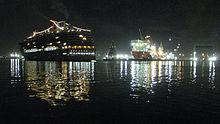
Since Tampa Bay was first spotted by Spanish explorers in the 16th century, sailors have admired its wide, sheltered beauty. However, its shallow nature has always presented a navigability problem; the bay is less than 30 feet (9.1 m) deep almost everywhere and considerably less than that in many places near the coast, including the approach to the city of Tampa.[110] By the late 19th century, typical cargo ships had grown large enough that they were not able to navigate upper Tampa Bay and reach the ports of Tampa at all.
In 1899, however, the US Congress authorized the dredging of a 27' deep channel to Port Tampa, Henry Plant's rail-to-ship facility just west of Tampa. In 1917, another channel was dredged out to the Port of Tampa proper, instantly making Tampa an important shipping location.[111]
The bay bottom is very sandy, and the ship channels need constant dredging to keep them navigable to the largest modern cargo ships. Every year, the US Army Corps of Engineers dredge up enough sediment from the bay to fill Raymond James Stadium 10 times.[112]
Today, the Port of Tampa is the largest port in Florida in throughput tonnage, making it one of the busiest commercial ports in North America.[113] Petroleum and phosphate are the lead commodities, accounting for two-thirds of the 37 million tons of total bulk and general cargo handled by the port in 2009.[114]
The Tampa Port Authority currently operates three cruise ship terminals in Tampa's Channel District. The Port of Tampa is the year-round home port for Carnival Cruise Lines' MS Carnival Inspiration and MS Carnival Legend. In 2010, Tampa will also be a seasonal port for Holland America Line's MS Ryndam, as well as Royal Caribbean International's MS Grandeur of the Seas and MS Radiance of the Seas.[115] A fourth company, Norwegian Cruise Line, has announced plans to sail out of Tampa for the first time. The 2,240 passenger MS Norwegian Star will be Tampa's largest cruise ship when it debuts a seasonal schedule in 2011. Cruise itineraries from Tampa include stops in the Eastern and Western Caribbean islands, Honduras, Belize, and Mexico.[116]
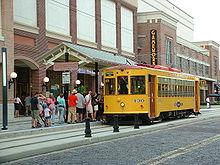
Public mass transit within Tampa is operated by the Hillsborough Area Regional Transit Authority (HART), and includes public bus and paratransit service, as well as a streetcar line. The HART bus system's main hub is the Marion Transit Center in Downtown Tampa, serving nearly 30 local and express routes. HART has a signed transit deal with the University of South Florida, allowing students to ride for free on most bus routes,[117] while students from other schools may receive discounted fares.[118]
In October, 2002, the TECO Line Streetcar System brought electric streetcar service back to Tampa for the first time in over half a century. The line operates from ten stations along a 2.4-mile (3.9-km) route, connecting Ybor City, the Channel District, the Tampa Convention Center, and downtown Tampa.[119] Work is currently underway to extend the line along Franklin Street to the Fort Brooke Parking Garage by December 2010. The TECO Line fleet features varnished wood interiors and other appointments reminiscent of the streetcars that traversed Tampa between the late 19th and mid-20th centuries. The nostalgic design is incorporated with modern functionality, as the cars are both wheelchair accessible and air conditioned.[120]
Limited transportation by privately-operated "Neighborhood Electric Vehicles" (NEV) is available, primarily in Downtown Tampa and Ybor City.[121] Water taxis are available on a charter basis for tours along the downtown waterfront and the Hillsborough River. Regular water taxi service may be possible in the future as docks and facilities are developed in conjunction with the Tampa Riverwalk.[122]
In July 2007, the Tampa Bay Area Regional Transportation Authority (TBARTA) was formed to develop bus, light rail, and other transportation options for the seven-county Tampa Bay area.
MacDill Air Force Base, located in south Tampa, was constructed as MacDill Field just prior to World War II. During the 1950s and 1960s, it was a Strategic Air Command base for B-47 and B-52 bombers. In the 1960s, it transitioned to a Tactical Air Command installation for F-4 Phantom II fighters, followed by F-16s in the 1980s. It is currently an Air Mobility Command installation, home to the 6th Air Mobility Wing, and includes both the 310th Airlift Squadron, flying the C-37, and the 91st Air Refueling Squadron, flying the KC-135. MacDill AFB is also home to the headquarters for two of the U.S. military's joint warfighting commands: Headquarters, United States Central Command (CENTCOM), and Headquarters, United States Special Operations Command (SOCOM). Both commands are independent from one another and each is commanded by a respective 4-star general or admiral.
The MacDill AFB flight line was temporarily closed and the 56th Fighter Wing transferred to Luke AFB, Arizona following the 1991 round of base closings under the Base Realignment and Closure Commission (BRAC) discussions; at the time, the base was used for F-16 fighter training and operations and increasing level of civilian air traffic in the Tampa Bay area was considered detrimental to training. The noise produced by the fighter aircraft was also considered inappropriate in a densely populated area. However, despite committee recommendations, the base remained open to house and support CENTCOM and SOCOM under the cognizance of the newly-activated 6th Air Base Wing. With the disestablishment of Tactical Air Command a few months later, claimancy for MacDill passed to the newly-created Air Combat Command.
The MacDill flight line was initially reopened in 1992 to temporarily support F-16 aircraft from the 31st Fighter Wing and the Air Force Reserve's 482d Fighter Wing, following the destruction of their home station, Homestead AFB, Florida in the wake of Hurricane Andrew. In 1993, the MacDill flightline was permanently reopened for NOAA WP-3D "hurricane hunter" operations, which had relocated from Miami International Airport.
In 1996, the 91st Air Refueling Squadron moved to MacDill from Malmstrom Air Force Base, Montana, the 6th Air Base Wing was renamed the 6th Air Refueling Wing (later 6th Air Mobility Wing) and the installation officially came under the Air Mobility Command.
Approximately 14,000 people work at MacDill Air Force Base, with a significant number of military personnel and their families living on base in military housing, while remaining servicemembers and military families live off base in the Tampa Bay area. MacDill AFB is a significant contributor to Tampa's economy and the city is very supportive of the military community. In 2001 and 2003, the Tampa Bay area was awarded the Abilene Trophy, which annually honors the most supportive Air Force city in Air Mobility Command.
MacDill also hosts an annual air show that is enjoyed by thousands of spectators each year. However, there were no shows in 2002 and 2003 due to 9/11.[123] The 2006 show was also canceled due to security concerns on base,[124] but was reinstated in 2008. In 2008, pursuant to BRAC 2005, the Air Force Reserve Command's 927th Air Refueling Wing (927 ARW) relocated without aircraft or equipment from Selfridge Air National Guard Base, Michigan to MacDill AFB, where it became an "Associate" wing to the 6th Air Mobility Wing sharing the same KC-135R Stratotanker aircraft.
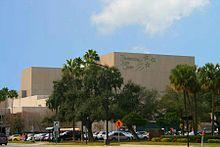
Tampa is home to a variety of stage and performing arts venues and theaters, including The David A. Straz Jr. Center for the Performing Arts, The Tampa Theatre, Gorilla Theatre, and just east of the city, the 1-800-ASK-GARY Amphitheatre.
Performing arts companies and organizations which call Tampa home include The Florida Orchestra, Opera Tampa, Jobsite Theater, The Master Chorale of Tampa Bay, Stageworks Theatre, Spanish Lyric Theater, and the Tampa Bay Symphony.
Current popular nightlife districts include Channelside, Ybor City, SoHo, International Plaza and Bay Street, and Seminole Hard Rock. Downtown Tampa also contains some nightlife, and there are more clubs/bars to be found in other areas of the city. Tampa is rated sixth on Maxim magazine's list of top party cities.[125]
The area has become a "de facto" headquarters of professional wrestling, with many pros living in the area.[126][127][128][129] WWE's developmental territory, Florida Championship Wrestling, is also based in Tampa.
Tampa is home to several death metal bands, an extreme form of heavy metal music that evolved from thrash metal. Many of the genre's pioneers and foremost figures are based in and around the city. Chief among these are Cannibal Corpse, Deicide, Six Feet Under, Obituary, and Morbid Angel. The Tampa scene grew with the birth of Morrisound Recording, which established itself as an international recording destination for metal bands.[130]
The underground rock band, the Baskervils, got their start in Tampa. They played the Tampa Bay area between 1994 ae1997 and then moved to New York City. Underground hip-hop group Equilibrium is based out of Tampa, as well as the Christian metalcore band, Underoath.
In 2009, the new Frank Wildhorn musical Wonderland: Alice's New Musical Adventure hosted its world premiere at the Straz Center.
The Tampa area is home to a number of museums that cover a wide array of subjects and studies. These include the Museum of Science & Industry (MOSI), which has several floors of science-related exhibits plus the only domed IMAX theater in Florida and a planetarium; the Tampa Museum of Art; the USF Contemporary Art Museum; the Tampa Bay History Center; the Tampa Firefighters Museum; the Henry B. Plant Museum; and Ybor City Museum State Park. Permanently docked in downtown's Channel District is the SS American Victory, a former World War II Victory Ship which is now a used as a museum ship.
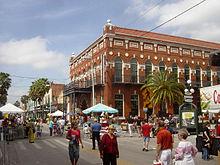
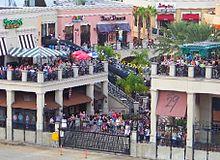
The city of Tampa operates over 165 parks and beaches covering 2,286 acres (9.25 km2) within city limits; 42 more in surrounding suburbs covering 70,000 acres (280 km2), are maintained by Hillsborough County. These areas include the Hillsborough River State Park, just northeast of the city. Tampa is also home to a number of attractions and theme parks, including Busch Gardens Tampa Bay, Adventure Island, Lowry Park Zoo, and Florida Aquarium.
Tampa's Lowry Park Zoo features over 2,000 animals, interactive exhibits, rides, educational shows and more. The zoo serves as an economic, cultural, environmental and educational anchor in Tampa.
Busch Gardens Tampa Bay is a 335-acre (1.36 km2) Africa-themed park located near the University of South Florida. It features many thrilling roller coasters, for which it is known, including Sheikra. Visitors can also view and interact with a number of African wildlife.
Adventure Island is a 30-acre (120,000 m2) water park adjacent to Busch Gardens. It features many water rides, dining, and other attractions typical to a water park.
The Florida Aquarium is a 250,000 sq ft (23,000 m2) aquarium located in the Channel District of Tampa. It hosts over 20,000 species of aquatic plants and animals. It is known for its unique glass architecture. Adjacent to the Aquarium is the SS American Victory, a World War II Victory ship preserved as a museum ship.
The Tampa Bay History Center is a museum of Tampa Bay History located in the Channel District, Tampa, Florida of Tampa. It boasts over 60,000 sq ft (5,600 m2) of exhibits through 12,000 years. Theaters, map gallery, research center and museum store.
Well-known shopping areas include International Plaza and Bay Street, WestShore Plaza, SoHo district, and Hyde Park Village.[131] Palma Ceia is also home to a shopping district, called Palma Ceia Design District.[132] Previously, Tampa had also been home to the Floriland Mall (now an office park), Tampa Bay Center (demolished and replaced with the new Tampa Bay Buccaneers training facility, known as "One Buc Place"), and East Lake Square Mall (now an office park).

Perhaps the most well known and anticipated events are those from Tampa's annual celebration of "Gasparilla", particularly the Gasparilla Pirate Festival, a mock pirate invasion held since 1904 in late January or early February. Often referred to as Tampa's "Mardi Gras", the invasion flotilla led by the pirate ship, Jose Gasparilla, and subsequent parade draw over 400,000 attendees, contributing tens of millions of dollars to the city's economy. Beyond the initial invasion, numerous Gasparilla festivities take place each year between January and March, including the Gasparilla Children's Parade, the more adult-oriented Sant'Yago Knight Parade, the Gasparilla Distance Classic, Gasparilla Festival of the Arts, and the Gasparilla International Film Festival, among other pirate themed events.[133]
Other notable events include the Outback Bowl, which is held New Year's Day at Raymond James Stadium. Each February, The Florida State Fair brings crowds from across the state, while "Fiesta Day" celebrates Tampa's Cuban, German, Italian, African-Cuban, Jewish and Spanish immigrant heritage. In April the MacDill Air Fest entertains as one of the largest military air shows in the U.S.. Guavaween, a nighttime street celebration infuses Halloween with the Latin flavor of Ybor City.[134] Downtown Tampa hosts the largest anime convention in Florida, Metrocon, a three-day event held in either June or July at the Tampa Convention Center.[135] Ybor also hosts "GaYbor Days", an annual street party in the GLBT-friendly GaYbor district.[136] The Tampa International Gay and Lesbian Film Festival, held annually since 1989, is the city's largest film festival event,[137] and one of the largest independent gay film festivals in the country.[138]
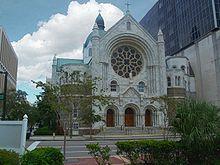
Communities of faith have organized in Tampa from 1846, when a Methodist congregation established the city's first church,[139] to 1939, when a 21-year old Billy Graham began his career as a spiritual evangelist and preacher on downtown's Franklin Street,[140] and through to today. Among Tampa's noteworthy religious structures are Sacred Heart Catholic Church, a 1905 downtown landmark noted for its soaring, Romanesque revival construction in granite and marble with German-crafted stained glass windows,[141] the distinctive rock and mortar St. James Episcopal House of Prayer, listed with the U.S. historic registry,[142] and the St. Paul A.M.E. church, which has seen the likes of Dr. Martin Luther King, Jr.,[140] and President Bill Clinton speak from its pulpit.[143] The later two have been designated by the city government as Local Landmark Structures.[144]
Tampa's religious community includes a broad representation of Christian denominations, including those above, and Presbyterian, Lutheran, Christian Science, Church of God, United Church of Christ, Philippine Independent Church, Unitarian Universalist, Metropolitan Community Church, Seventh-day Adventist, Eastern Orthodox (Greek, Coptic, Syrian, and OCA), various Pentecostal movements, Anglicans, the Quakers, Jehovah's Witnesses, and the Church of Jesus Christ of Latter-day Saints. Tampa also has several Jewish synagogues practicing Orthodox, Conservative, and Reform.
Around the city are located a handful of mosques for followers of Islam, as well as a Tibetan-style Buddhist temple, a Thai Buddhist Wat,[145] and local worship centers for the Hindu and BahR¡'R faiths. The Church of Scientology, based in nearby Clearwater, maintains a location for its congregants in Tampa.[146]
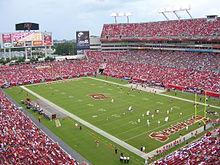
Tampa is represented by teams in three major professional sports leagues: the NFL, the NHL, and Major League Baseball. The NFL's Tampa Bay Buccaneers and the NHL's Tampa Bay Lightning call Tampa home, while the Tampa Bay Rays of Major League Baseball play across the bay in St. Petersburg. As indicated by their names, these teams, plus several other sports teams, represent the entire Tampa Bay metropolitan area. In addition to these teams, the Orlando Magic of the NBA play about an hour and a half away from the Tampa area.
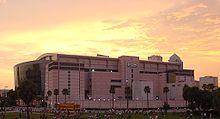
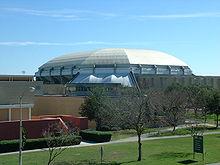
Tampa has formalized sister city agreements with the following cities:[148]

Word Count: 10533





